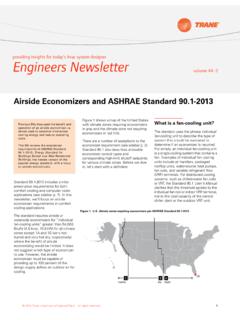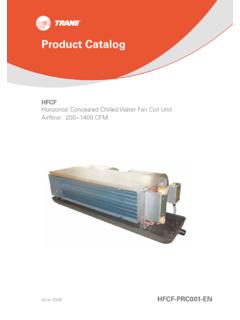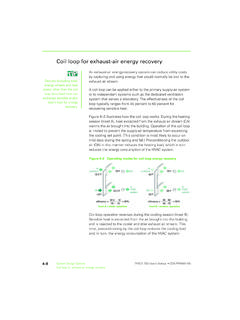Transcription of Fantastic - A closer look at fan efficiency metrics - …
1 Providing insights for today's hvac system designer Engineers newsletter volume 43 3. Fantastic ! A closer look At Fan efficiency metrics Application-Independent vs. Total Pressure Versus Static This EN will explore two of the most Application-Dependent. The subject of Pressure. Fan efficiency metrics tend talked-about fan efficiency metrics (Fan efficiency Grade and Performance dependency on the fan's operating point is to be defined in terms of total pressure. Based efficiency Requirement), and an important one. Depending on the Fan total pressure is the total pressure identify their benefits and limitations. It authority of the organization utilizing fan (static pressure plus velocity pressure). will conclude with a summary of where at the fan outlet minus the total efficiency metrics , they may have and how these metrics are currently being applied in standards and codes.
2 Influence over the manufacturer, the pressure at the fan inlet. It is a measure designer, or both. Let's therefore broadly of the total mechanical energy added to characterize the metrics based on whether the air by the fan. the fan's operating point is being considered: On the other hand, static pressure is Types of Fan efficiency total pressure minus velocity pressure. Application-Independent: An efficiency By definition, fan static pressure is the metrics metric in which the fan's actual total pressure at the fan outlet minus operating point is not considered. the total pressure at the fan inlet minus Fans are at the heart of every air- distribution system so it makes sense that Application-Dependent: An efficiency the velocity pressure at the fan outlet. improvements to fan system design metric in which the fan's actual This can be a source of confusion.
3 Coupled with higher efficiency fans can operating point is considered. When the fan inlet is unducted, the provide substantial HVAC energy savings. inlet velocity pressure is zero and the The Air Movement and Control Association As we will see, some metrics function total pressure equals the static (AMCA) estimates that fans consume better as one dependency type over pressure. However, when the inlet is between 30% and 40% of commercial another. ducted, care must be taken in the field HVAC energy.* Improving fan efficiency is to measure the total pressure at the therefore an important next step towards Product efficiency vs. System inlet rather than just the static pressure. reducing global, overall energy use. efficiency . The next subject segregates When the outlet is unducted, the outlet the fan (product) itself and the overall velocity pressure is zero, in which case Before diving in, we need to explain some system: the change in fan total pressure will terminology to better understand the equal the change in fan static pressure.
4 Usefulness and limitations of each fan Product efficiency : The efficiency efficiency metric. metric considers the fan alone To ensure all forms of energy are System efficiency : The efficiency accounted for, the total pressure should metric considers the overall system, be considered for ducted systems. Note including fan system effects, duct that many engineers will design their leakage, duct design, etc. systems using only static pressure. They are still accounting for any velocity * Even if a fan has a high peak efficiency , pressure changes and, therefore, total W. Smith, 2012 Fan Market Data Defines the Path to Higher efficiency AMCA International inmotion how one applies that fan in a system will pressure changes by ensuring the duct August 2014. ultimately determine how much energy connection to the fan matches the will be used.
5 The impact of the system on intent ( , 3 duct diameters of straight fan energy use heavily outweighs the duct sized the same as the fan outlet). impact of the fan alone. and by using dynamic loss coefficients ("Kt" factors). 2014 trane , a business of Ingersoll Rand. All rights reserved. 1. Extended Product ( , wire-to- Figure 1. Overall efficiency of a complete fan system gas). Let's briefly explore an important aerodynamic topic that's not addressed in today's input electrical fan shaft loss power codes and standards. The metrics power mechanical loss currently being discussed tend to address only the power applied to the fan shaft. AMCA will soon release AMCA Publication 207, Fan System mechanical air efficiency and Fan System Input Power main control motor fan power drive Calculation, which will provide guidance, a method, and tabulated data to calculate fan system input power and overall efficiency of the complete fan system (see Figure 1).
6 This will drive loss include the fan efficiency , the electric motor loss motor efficiency , and the efficiency of control loss the power transmission and/or motor controller, if present. efficiency when compared to a larger fan. Direct measurement of input kW is As shown in Figure 2, this change can be preferred, but this publication will at Note: There is a version of the Fan rather dramatic as the diameter is least give manufacturers and other efficiency Grade (FEG) metric that increased even for the same type of fan. interested parties a common basis for incorporates input power: Fan Motor Consider the area in the shaded box. A. calculation and comparison. efficiency Grade (FMEG). The metric is not single-number efficiency limitation (such widely used in the , where the fan is as > 65%) would either a) effectively The Air-Conditioning, Heating & often sold separate from the motor and/or eliminate the use of smaller diameter fans Refrigeration Institute (AHRI) recently motor controller, but it is an important or b) require a limit so lenient (such as published another important step metric in the European Union, where fan- > 45%) that it would have little impact on towards an accurate, calculated system motor-drive combinations are more reducing building energy use.
7 Input power: AHRI Standard 1210, commonly sold. Performance Rating of Variable FEGs solve this small fan diameter Frequency Drives. This standard will The first question we need to ask is: Why dilemma by accounting for the impact provide a uniform method of measuring can't we use the simple fan efficiency diameter has on fan efficiency . and comparing Variable Frequency calculation, rather than something more Drives by establishing testing and complicated like FEG? Let's look at the The FEG classification number alone is an rating requirements. impact of fan diameter on efficiency . application-independent metric, based on the peak aerodynamic efficiency of a Larger Fans vs. Smaller Fans. Increased ducted fan separate from its motor and turbulence and tolerance magnification drive. It's important to note, however, that Fan efficiency Grade (FEG) result in smaller fans operating at a reduced the fan's peak aerodynamic efficiency will not ultimately determine how much Many of the latest energy codes and standards, including the American Figure 2.
8 Fan size versus total efficiency comparison Society of Heating, Refrigerating and 90. Air Conditioning Engineers (ASHRAE). Standard , reference a fan 80. efficiency classification system known fan peak total efficiency (%). as Fan efficiency Grade (FEG). The FEG. metric was defined when AMCA 70. published Standard 205 in 2010. It was first adopted into ASHRAE Standard 60. through Addendum u to the 2010 airfoil version, and is now included in backward curve 50 mixed impeller ASHRAE It has also been backward incline adopted by the International Green forward curve Construction Code (IgCC) and is being 40. considered for a number of other model construction and energy codes. 30. FEG is by far the most commonly 0 5 10 15 20 25 30 35 40. applied fan efficiency metric in use fan size (impeller diameter) (in.)
9 Today. Image courtesy of AMCA International. 2 trane Engineers newsletter volume 43-3 providing insights for today's HVAC system designer energy is used. Even with a highly Figure 3. Fan minimum efficiency window efficient fan, that fan could be selected to operate at a point far from this peak Pt efficiency . peak To use FEG as an application-dependent peak -15. metric, the FEG classification number can be accompanied by an allowable selection range or window . This is accomplished by defining a number of percentage points from peak efficiency ; as shown in Figure 3. Pt Note that the selection window is in terms of percentage points; not a percentage. For example, if the peak flow Qmin Qpeak Qmax efficiency is 70%, a 15-point window means that the fan must be selected with Image courtesy of AMCA International.
10 ANSI/AMCA Standard 205-12, Energy efficiency Classification For Fans. an efficiency of at least 55% (not x 70% = ). by the minimum FEG level prescribed by data in accordance with a standard like AMCA 210. If an equipment-mounted fan is the appropriate code or standard. As Since FEG ratings are an indicator of peak being evaluated (see sidebar ), the described earlier, the designer is then fan efficiency , and not actual operating equipment manufacturer will need to expected to determine whether the efficiency , their main value is in provide two data sets: a fan component desired fan operating point meets the segregating fans during selection. Once performance data set and an equipment allowable selection window requirement. an engineer has narrowed a list of available fans to only those that meet the performance data set.










